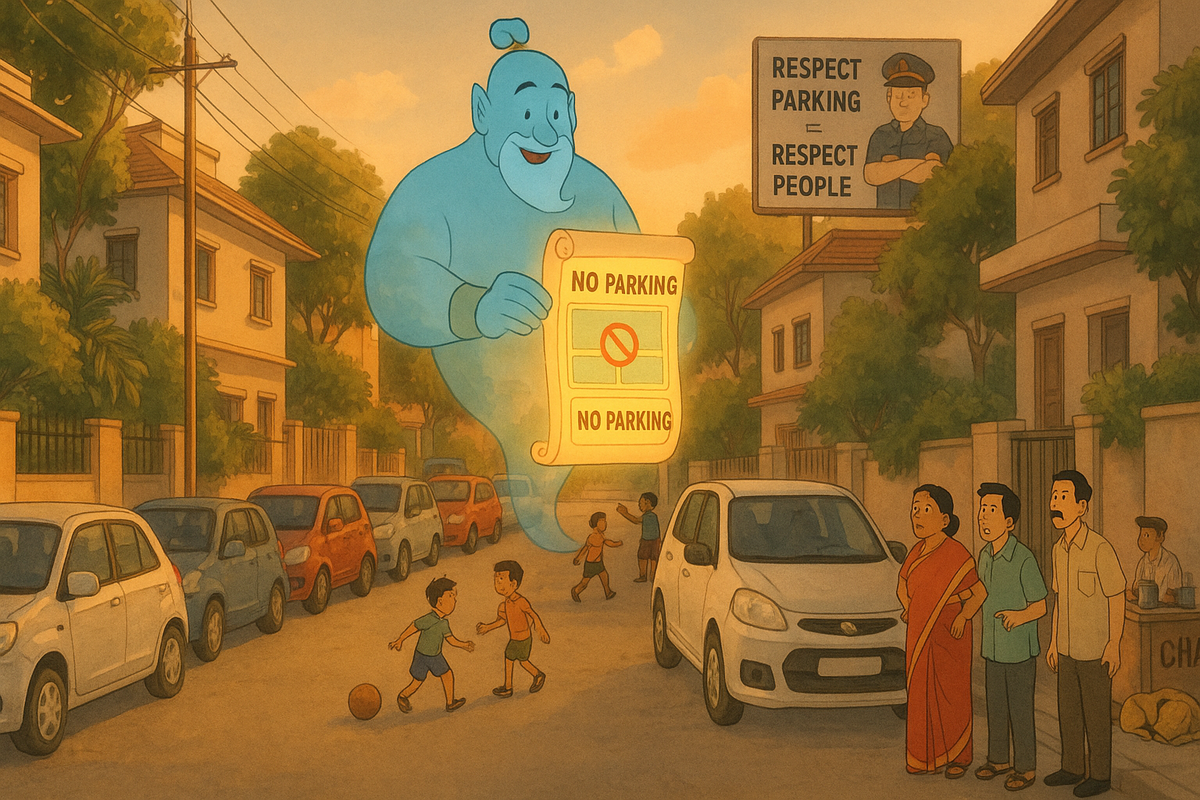Urban Parking 101: What’s Legal, What’s Not
Learn what counts as illegal parking in India, where you can get towed, and how to avoid fines. SpotGenie breaks down no-parking zones and smart tips.

🧞♂️ Hello again, thoughtful parker! It’s your SpotGenie here, watching the city’s wheels from above. Today, we talk about something deceptively simple — parking. Because when your car rests wrong, trouble wakes up fast.
1. Introduction: Parking Isn’t Just Space — It’s Law
In India’s bustling cities, parking has become both a quest and a gamble. Finding a slot can feel like striking gold — but misplacing your vehicle by just a few meters could lead to a fine, towing, or even a neighbor’s fury.
Most drivers focus on finding space, but forget the rules that govern that space. Urban parking is not just about convenience — it's a matter of legal placement, civic responsibility, and public safety.
Let’s decode the official (and often invisible) parking rulebook, so you can leave your vehicle with peace of mind.
2. Types of No-Parking Zones Explained
Every city has designated areas where parking is restricted or banned outright — not just for aesthetics, but for functionality, safety, and emergency access. Here are the most common types of no-parking zones:
- School Zones: Parking near school gates during operating hours is prohibited to avoid traffic bottlenecks and ensure child safety.
- Fire Exits & Emergency Lanes: Blocking these can attract heavy fines and even criminal charges.
- Signal Corners & Intersections: Vehicles should be parked at least 50–100 feet away from signals to maintain visibility and flow.
- Private Gates & Building Entrances: Unauthorized parking in front of homes or shop gates is illegal and often leads to complaint-based towing.
- Hospital Vicinities: These are often marked as ‘No Parking’ to ensure quick ambulance access.
Some of these zones are clearly marked with signs or paint — but many are unmarked, relying on common sense and civic courtesy.
3. Towing Triggers: What Gets Your Vehicle Lifted
Wondering why your car got towed? It may not be personal — but it’s likely procedural. Towing authorities act under specific guidelines issued by the local RTO or traffic police departments. Here’s what usually prompts action:
- Parking in a designated “No Parking” zone (marked or reported)
- Blocking access points: Driveways, hydrants, or even metro gates
- Obstruction complaints: Filed by residents or shops to city helplines
- Peak-time restrictions: Some areas allow parking only during off-peak hours
In most Tier-1 cities like Mumbai, Delhi, and Pune, towing is digitized. Some cities also publish real-time lists of towed vehicles online — so you can check status without panic.
Genie tip: If you're unsure, a 10-second glance for signage or yellow lines can save you a ₹2,000 headache.
4. Penalties, Fines & Spot Checks
Parking in the wrong spot doesn’t just risk towing — it can burn a hole in your wallet. Here’s what the law says, and what it costs to ignore it:
- No Parking Fine: ₹500–₹1,000 depending on the city and zone
- Towing Charges: ₹200–₹700 for two-wheelers, ₹500–₹2,000 for four-wheelers
- Repeat Violations: May attract license points or escalated fines
- Blocking Emergency Routes: Can include FIRs and criminal sections under IPC
Traffic police in Bengaluru, Mumbai, and Hyderabad now use handheld devices for spot challans. And in some cities, your vehicle’s location is photographed before towing for legal record.
Pro tip: If you find an e-challan on your windshield, pay it via the official Parivahan site or mParivahan app to avoid penalty escalation.
5. Parking Smart in Crowded Cities
With vehicle ownership rising and space shrinking, smart parking is the future. Here’s how to be a savvy urban parker:
- Choose Malls or Pay Lots: Safer, monitored, and legally compliant
- Try Rotational Parking: Common in societies — share spots based on need/time
- Look for QR-based Signage: Some cities like Pune have started using digital boards to show parking availability
Yes, it might cost ₹20 more — but it saves you time, fines, and confrontation. That’s a trade worth making.
6. Conclusion: Leave It Right, Walk Away Light
Parking right isn’t just about avoiding trouble — it’s about making the city move better. Every car well-placed is one less conflict, one more smooth lane, and one step toward a more responsible road culture.
As your ever-patient Genie, I say this: parking isn’t just about space — it’s about respect. For laws, for neighbors, for movement. Find the right spot, respect the boundaries, and walk away knowing your wheels — and conscience — are safe.
Keywords: urban parking rules India, no parking zone laws, towing rules India, illegal parking fine India, traffic parking violation, where not to park India, parking near school gate fine, fire exit parking rules, vehicle towing triggers, SpotGenie parking tips, mParivahan challan, legal parking guide India, smart parking India, how to avoid parking fine, Gyaan SpotGenie blog
Follow us on:
🅾 Instagram |
ⓕ Facebook |
𝕏 X |
▶️ YouTube |
🟢 WhatsApp
🚧 More SpotGenie Gyaan – Navigate Indian Roads Smartly
- Do You Even Know the Rules? Top Traffic Fines Most Indians Still Miss
- How SpotGenie Helps Prevent Towing Disasters Before They Start
- Why Every Driver Needs SpotGenie – The Smart QR Sticker for Alerts
- When It’s Not a Parking Spot – It’s a Problem You Can Solve with SpotGenie
- Get SpotGenie Today – Avoid Parking Fines and Stay Informed
Parking is more than just finding space — it's about knowing the rules. SpotGenie helps you park smart, stay safe, and avoid fines.



